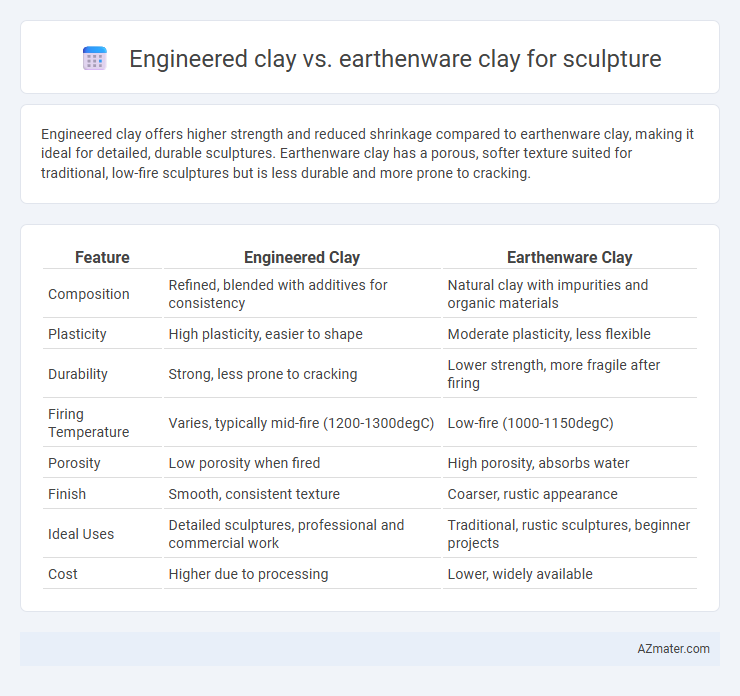Engineered clay offers higher strength and reduced shrinkage compared to earthenware clay, making it ideal for detailed, durable sculptures. Earthenware clay has a porous, softer texture suited for traditional, low-fire sculptures but is less durable and more prone to cracking.
Table of Comparison
| Feature | Engineered Clay | Earthenware Clay |
|---|---|---|
| Composition | Refined, blended with additives for consistency | Natural clay with impurities and organic materials |
| Plasticity | High plasticity, easier to shape | Moderate plasticity, less flexible |
| Durability | Strong, less prone to cracking | Lower strength, more fragile after firing |
| Firing Temperature | Varies, typically mid-fire (1200-1300degC) | Low-fire (1000-1150degC) |
| Porosity | Low porosity when fired | High porosity, absorbs water |
| Finish | Smooth, consistent texture | Coarser, rustic appearance |
| Ideal Uses | Detailed sculptures, professional and commercial work | Traditional, rustic sculptures, beginner projects |
| Cost | Higher due to processing | Lower, widely available |
Introduction to Sculptural Clays
Engineered clay offers consistent texture, reduced shrinkage, and enhanced durability, making it ideal for detailed sculptural work that demands precision. Earthenware clay, valued for its natural composition and porosity, provides a traditional medium favored for organic forms and tactile surfaces in sculpture. Choosing between engineered clay and earthenware depends on project requirements, with engineered clay suited for intricate designs and earthenware preferred for expressive, rustic aesthetics.
What is Engineered Clay?
Engineered clay is a specially formulated sculpting material designed for consistent texture, durability, and ease of manipulation, often combining natural clay with synthetic additives to enhance performance. Unlike traditional earthenware clay, which is porous and less refined, engineered clay offers improved structural integrity and reduced cracking risk during drying and firing. Artists commonly use engineered clay for detailed sculptures requiring precision and longevity, benefiting from its uniform composition and predictable behavior.
What is Earthenware Clay?
Earthenware clay is a porous, low-fire clay typically fired between 1,000degC and 1,150degC, making it softer and more malleable than engineered clay, ideal for detailed sculptural work. Unlike engineered clay, earthenware retains a natural, earthy texture and color, offering a rustic aesthetic favored in traditional pottery and sculpture. Its lower firing temperature allows for quicker production but requires careful handling due to its fragility and susceptibility to water absorption.
Physical Properties Comparison
Engineered clay offers consistent plasticity and reduced shrinkage, making it ideal for detailed sculptural work, while earthenware clay tends to be more porous and less durable after firing. The higher firing temperature of engineered clay results in increased strength and resistance to cracking compared to the lower-fired, more fragile earthenware. Moisture retention in earthenware is greater, which can affect workability and drying time, whereas engineered clay maintains a more stable moisture content, promoting easier manipulation during sculpting.
Workability and Sculpting Techniques
Engineered clay offers superior workability compared to earthenware clay due to its consistent texture and plasticity, allowing for intricate detailing and smooth finishes in sculpture. Earthenware clay tends to be more porous and less flexible, making it ideal for hand-building techniques but challenging for fine sculptural work requiring precision. Sculptors often prefer engineered clay for complex modeling and delicate features, while earthenware clay suits more organic forms and traditional methods like coiling and pinching.
Firing Temperatures and Durability
Engineered clay typically fires at higher temperatures, around 1200degC to 1300degC, resulting in increased vitrification and improved durability compared to earthenware clay, which fires at lower temperatures between 1000degC and 1150degC. This higher firing range makes engineered clay less porous and more resistant to chipping and cracking, ideal for sculptures requiring longevity and structural integrity. Earthenware clay remains more porous after firing, offering a softer finish but less durability, suitable for decorative or indoor sculptures.
Color and Surface Finishes
Engineered clay offers consistent color and smooth surface finishes due to its refined composition and controlled manufacturing process, making it ideal for precise sculptural details and vibrant glazes. Earthenware clay typically exhibits natural, earthy tones ranging from red to brown with a slightly porous texture, providing a rustic and organic surface finish that enhances traditional and folk art sculptures. Both clays react differently to glazes and firing temperatures, influencing the final color saturation and texture on sculptural pieces.
Environmental Impact and Sustainability
Engineered clay offers improved durability and reduced waste due to its controlled composition, making it a more sustainable choice compared to traditional earthenware clay, which often involves higher energy consumption in firing and sourcing natural materials. Earthenware clay, while biodegradable, typically requires extensive mining, leading to habitat disruption and increased carbon footprint. Selecting engineered clay for sculpture reduces environmental impact by minimizing raw material extraction and optimizing kiln efficiency for lower greenhouse gas emissions.
Cost and Availability
Engineered clay for sculpture typically costs more due to its specialized composition and consistency, while earthenware clay is more affordable and widely available in local art supply stores. Engineered clay offers uniform texture and fewer impurities, but earthenware's abundance and natural sourcing make it accessible for beginners and budget-conscious artists. Availability of earthenware is high worldwide, whereas engineered clay might require purchase through specialized suppliers or online retailers.
Choosing the Right Clay for Your Sculpture
Engineered clay offers a consistent texture and controlled drying times ideal for detailed and delicate sculptures, while earthenware clay provides a natural, porous quality suited for rustic or traditional pieces. Choosing the right clay depends on the desired finish, firing temperature, and project durability, with engineered clay supporting fine detail and earthenware clay excelling in expressive, organic forms. Consider the sculpture's intended environment and handling requirements to determine whether the stability of engineered clay or the breathable nature of earthenware clay better suits your artistic goals.

Infographic: Engineered clay vs Earthenware clay for Sculpture
 azmater.com
azmater.com